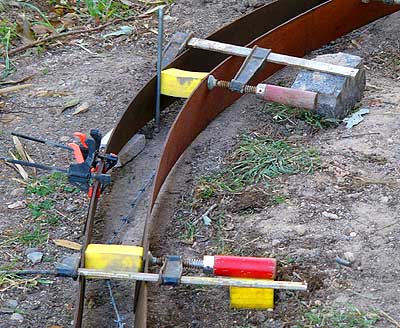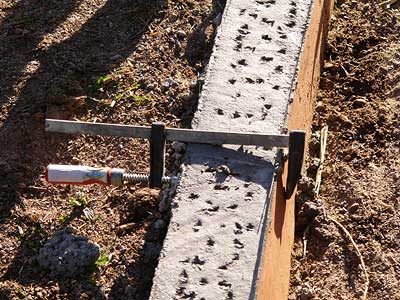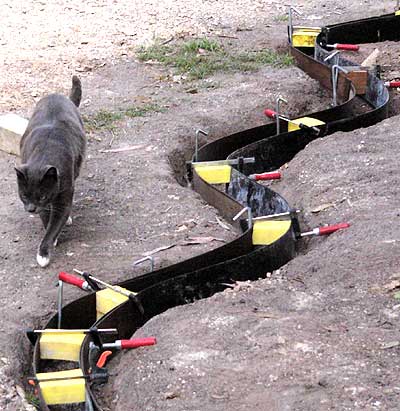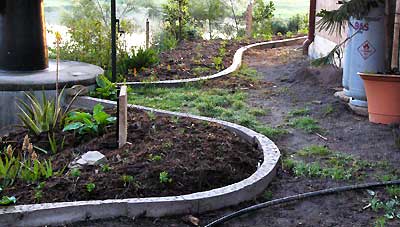| pallets of sandstone awaiting still |
|
Sandstoning the apron
part II
Defining boundaries
As the surrounding ground was fairly uneven - certainly far too bumpy to consider laying sandstone on it as it was - we needed to create an level base to work on.
The obvious choice of using a machine to level the surround was considered too risky given the lack of space and the number of water, gas, phone and electricity conduits in the vicinity.
It was also fairly obvious that, in some places, the surface needed raising to achieve a useful level in relation to the doorsteps.
|
Boundary conditions
So we elected to pour a concrete edge by hand which would provide a perimeter inside which we could fill and level a suitable base.
It seemed appropriate to use a fairly free-form curved organic line to complement the Temple's straight lines.
|
|
The perimeter pour |
| the edge formwork with the barbed wire in place |
|
The edge formwork
We wanted to avoid a complex and costly formwork construction but wished to achieve something complimentary to the environment.
The temple has few curved lines and the environment few straight ones, so a curved perimeter seemed the best design.
However pouring freestyle curves is not such a straightforward task and we wanted to avoid complicated and costly formwork construction.
We used 100mm wide strips of 6mm hardwood bracing plywood for the formwork.
|
|
The initial formwork looks quite fragile but, once filled with concrete, becomes much more resilient and robust and can be realigned (within reason) for fine adjusting.
We used high-tensile barbed wire - for its excellent strength and rust-resistant properties - as reinforcing. We had removed a fair amount from old fences on the new portion of the land and it seemed sensible to recycle them.
The formwork was initially positioned using tent pegs, 100mm-wide blocks of a very firm foam and small F-clamps.
|
|
the finished pour |
| Rastus is inspecting the formwork |
|
As the concrete was shoveled in the blocks of foam were removed, the barbed wire positioned roughly in the centre of the wet concrete and the clamps tightened to determine the width of the edge and create some pre stressing.
Once the concrete had started to go off, we made a series of dents with a trowel to create a key for the mortar which would support the sandstone forming the outside edge of the pathway.
The plywood wouldn't conform to some of the tighter bends without cracking and we switched to plastic lawn-edging strips which worked just as well.
|
Boundary complete
Eventually the perimeter became complete and we had a boundary running right around the Temple.
It was, in places, irregular but, since the edge strip would be totally covered, we weren't unduly concerned about the variances.
|
|
A section of the edge strip |
|
|












